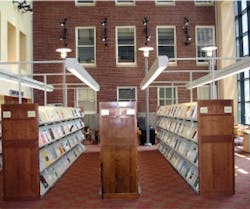Soundmasking is a familiar technology that fulfills a common need in open office spaces. It creates privacy and keeps workers from being distracted by sudden or abrupt noises.
In addition to typical open office environments, soundmasking has found applications in other spaces, some of which require more unique solutions for acoustic control and aesthetic concerns. The Schow Science Library at Williams College in Williamstown, MA, is an example.
Not So Silent Library
The Schow Science Library comprises two 6,000-square-feet atria with 40-foot ceilings, skylights, and walls made of brick, glass, and plaster. While patrons appreciated the architecture, they did not appreciate the loudness of the spaces.
"The college discovered that the students thought that it was a very distracting place to be because anything that went on in there – people walking around, closing books, dropping things – was very distracting," says Chris Savereid, president of Acentech and a supervisory consultant in architectural acoustics and noise control.
To prevent these noises from becoming distractions, it was decided that background noise should be introduced. However, because these library spaces did not have plenums, an in-plenum soundmasking system was not an option. As a result, direct-field soundmasking systems were evaluated.
In direct-field systems, speakers are located in the ceiling, and their sounds are transmitted directly to occupants, unlike in-plenum systems, which transmit the sounds to the plenum first and from there to the occupants. "Direct-field speakers are small, affordable, and have a broad dispersion coverage pattern," explains Savereid. "In addition, one of the big benefits of direct-field is that you’re no longer dealing with the filtering effect of sound passing through a structure. The speakers are in the space with the people who are listening to them, and you can control and equalize them to a high degree." Ultimately, a direct-field system from Cambridge Sound Management was installed in the library.
Other tall spaces with high reverberation may also be good applications for direct-field technology. Museums, lobbies, and atria are often made of glass, stone, wood, and other materials that don’t absorb sound. To prevent sounds from being heard throughout such spaces, soundmasking may be an option.
Impede Reverberation, Not Audibility
However, masking the sound is not always the goal and can sometimes be a downfall. In some spaces, occupants want to hear the sound but not the associated reverberation. In these cases, adding sound-absorbing treatments will reduce the reverberation and make the space appear quieter without reducing the audibility of disseminated information, which can be crucial in areas where there are frequent (and important) announcements over a PA system. And thanks to advancing technology, you can add sound-absorbing finishes that don’t detract from the architectural character of the space.
"There are some museums in the Boston area that have done a very clever job of working with an acoustical consultant to use finishes that most people who walk in just think are normal finishes," he says. "There are products on the market now that have the appearance of, for example, painted gypsum board, but have a permeable surface that lets sound energy pass through it and into the insulation below."
Not All Noise Is Negative
Surprisingly, the loudest spaces may appear to have the least level of distraction to users. "A few years ago a colleague of mine conducted a survey of college libraries and ranked them on their attractiveness to users," Savereid says. "What was fascinating, but not surprising, was that people liked best the libraries with the highest background sound levels – due to soundmasking or the HVAC systems – and considered them the quietest."
Kylie Wroblaski is associate editor of BUILDINGS.
.
